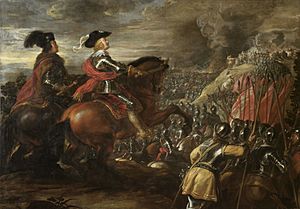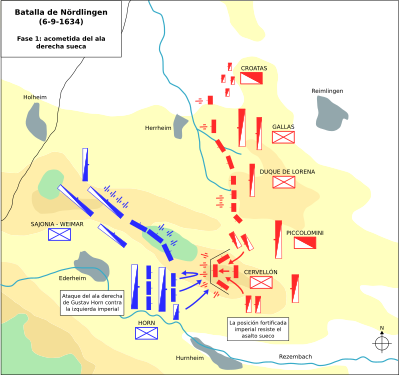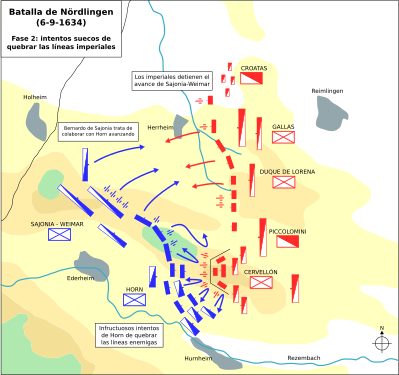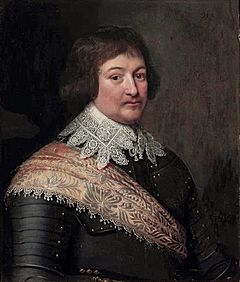Battle of Nördlingen (1634) facts for kids
Quick facts for kids Battle of Nördlingen |
|||||||
|---|---|---|---|---|---|---|---|
| Part of Thirty Years' War | |||||||
 The Battle of Nördlingen by Jan van den Hoecke |
|||||||
|
|||||||
| Belligerents | |||||||
| Commanders and leaders | |||||||
|
|||||||
| Strength | |||||||
|
33,000 20,000 infantry 13,000 cavalry 50 guns |
25,700 16,000 infantry 9,700 cavalry 68 guns |
||||||
| Casualties and losses | |||||||
| 3,500 killed or wounded | 8,000–12,000 killed or wounded 4,000 captured |
||||||
The Battle of Nördlingen was a major battle during the Thirty Years' War. It happened on September 6, 1634, near the town of Nördlingen in Germany. In this battle, a strong army of the Holy Roman Empire and Spain fought against the armies of Sweden and their German allies, the Heilbronn League.
The Imperial-Spanish forces won a huge victory. This defeat was a big setback for Sweden and its allies. It changed the course of the war, making France join the fight directly.
Contents
What Led to the Battle?
Sweden Joins the War
The Thirty Years' War was a long conflict in Europe. It involved many countries and was partly about religion. In 1630, Sweden joined the war. Their king, Gustavus Adolphus, led about 18,000 soldiers into Germany. France helped Sweden by giving them money. Sweden also had allies like Saxony and Brandenburg-Prussia.
Gustavus Adolphus won important battles. These included Breitenfeld in 1631 and Rain in 1632. Sadly, Gustavus Adolphus died in battle in 1632.
New Alliances and Challenges
After their king's death, Sweden and its German Protestant allies formed the Heilbronn League. France continued to support them with money. In 1633, they defeated an Imperial army. The Holy Roman Emperor, Ferdinand II, then removed his top general, Albrecht von Wallenstein. Wallenstein was later killed.
Removing Wallenstein made the Emperor stronger. But it also meant he relied more on Spain's army. Spain wanted to reopen the "Spanish Road." This was a land route used to move soldiers and supplies from Italy to the Dutch Republic. Spain was fighting a long war against the Dutch. So, the focus of the war shifted to the Rhineland and Bavaria.
The Spanish Army Arrives
Cardinal-Infante Ferdinand, a Spanish leader, gathered an army of about 11,700 soldiers in Italy. In May, they crossed the Alps mountains. They met up with other Spanish forces, making their army about 18,000 soldiers and 4,000 cavalry.
Swedish and German Plans
The Swedish and German armies were spread out. Gustav Horn tried to stop the Spanish. Bernhard of Saxe-Weimar tried to strengthen his position. Neither plan worked well. This left the city of Regensburg open to attack. An Imperial army of 25,000 soldiers, led by Ferdinand of Hungary, besieged Regensburg.
Horn and Bernhard met up and marched towards the Bohemian border. They hoped this would make Ferdinand stop the siege. They even defeated an Imperial force at Landshut. But the siege of Regensburg continued, and the city surrendered on July 26.
March to Nördlingen
Ferdinand of Hungary then marched his 15,000 men along the Danube River. He reached Donauwörth and then turned to besiege Nördlingen. This town was held by a Swedish army. Horn and Bernhard marched to Bopfingen. They waited to attack, thinking the Imperial army would have to leave because they were running out of supplies and suffering from plague.
However, on September 2, Ferdinand of Hungary was joined by his Spanish cousin, Cardinal-Infante Ferdinand. Nördlingen almost fell to an attack two days later. The Protestant commanders decided they had to fight. They had just gotten 3,400 more men. Horn wanted to wait for even more troops, but Bernhard argued they couldn't. He thought the Spanish reinforcements were small, but they were actually over 18,000! This meant the Habsburg army had over 33,000 soldiers. The Protestant army had only about 26,000, including 8,000 poorly trained local soldiers.
The Battle Begins
- The Battle in Three Maps
-
Phase 1; (Blue) Swedish assault takes the Albuch before being repulsed by (red) Spanish infantry and Bavarian cavalry led by Ottavio Piccolomini
On September 5, the Protestant army moved to a line of hills south of Nördlingen. Around 4 PM, Bernhard's soldiers met Spanish and Imperial guards. The two Ferdinands decided to hold their ground. Fighting continued until after midnight. The Habsburg forces lost some hills but kept the Albuch hill. This hill was very important because it stopped the Protestants from going around their army.
About 6,600 Spanish and 1,500 Bavarian soldiers held the Albuch. They dug trenches and set up 14 cannons. Bavarian cavalry were placed behind them. The rest of their army stretched north to Nördlingen.
Attacks on the Albuch
Gustav Horn's infantry and 4,000 cavalry were ordered to capture the Albuch hill. If they took it, the Spanish-Imperial forces would have to leave Nördlingen. Bernhard's troops were supposed to distract the Imperial right side. But Bernhard was greatly outnumbered, so he could only do small skirmishes.
At 5 AM on September 6, the Swedish cannons started firing at the Albuch. Then, a general attack began. The first wave of Swedish soldiers was pushed back with many losses. But the second wave, made of experienced soldiers, pushed back the Bavarian infantry. For a short time, it looked like Horn had won.
However, a wagon full of gunpowder exploded. This caused confusion among the Swedish soldiers. The Spanish infantry took advantage of this and pushed the Swedes back to where they started.
The Fight Continues
Horn gathered his men and attacked the Albuch many more times over the next few hours. But the experienced Spanish soldiers pushed them back every time. Bernhard's clever use of cannons on the left side kept the Imperial forces busy. But the Imperial and Spanish armies had more soldiers. This allowed their commanders to keep sending fresh troops to the Albuch.
Two groups of Bernhard's infantry joined the attack. But Bavarian cavalry attacked them before they reached the hill. An attack by Bernhard's own cavalry was also forced back. By midday, Horn's soldiers were tired. They had tried to capture the Albuch up to 15 times. They began to retreat.
Protestant Collapse
As Horn's men pulled back, Bernhard's infantry on the other hills were left exposed. At the same time, Croatian light cavalry went around his left side. Under this pressure, the Protestant army fell apart. They suffered heavy losses as the Imperial and Spanish forces chased them.
Two thousand of the local soldiers guarding the supplies were killed. Another 4,000 were captured. Most of these captured soldiers joined the Imperial army. One of the Protestant commanders, Scharffenstein, was captured and later executed. Horn was also captured and held prisoner until 1642. In total, the Protestants lost 8,000 to 12,000 soldiers killed or wounded. The Imperial and Spanish forces lost about 3,500. Bernhard and von Taupadel reached Heilbronn with the remaining 12,000 men a few days later.
What Happened After?
A Major Turning Point
The Battle of Nördlingen was a huge turning point in the war. It greatly weakened Sweden's power in southern Germany. The Imperial army took back most of the area. Sweden's leader, Axel Oxenstierna, faced pressure to end the war. In December, two of Sweden's main allies, Saxony and Hesse-Darmstadt, made peace with Emperor Ferdinand. This was later made official in the Treaty of Prague in May 1635. This treaty is often seen as the point where the Thirty Years' War stopped being mainly a German religious conflict.
France Joins the Fight
The defeat of the anti-Habsburg alliance in Germany led France to get directly involved. In 1635, Cardinal Richelieu of France signed a treaty with the Dutch. They planned a joint attack in the Spanish Netherlands. A French army also cut off the Spanish Road.
In April, France made a new alliance with Sweden. They also paid for an army of 12,000 soldiers for Bernhard of Saxe-Weimar. In May, France officially declared war on Spain. This started the Franco-Spanish War. Two years after Nördlingen, the battle of Wittstock in October 1636 was a big victory for the Swedish forces. This showed the Imperial forces that the Swedish army was still strong.
See also
 In Spanish: Batalla de Nördlingen (1634) para niños
In Spanish: Batalla de Nördlingen (1634) para niños





